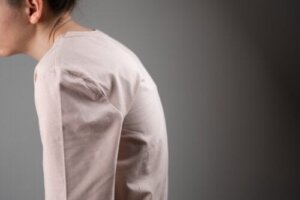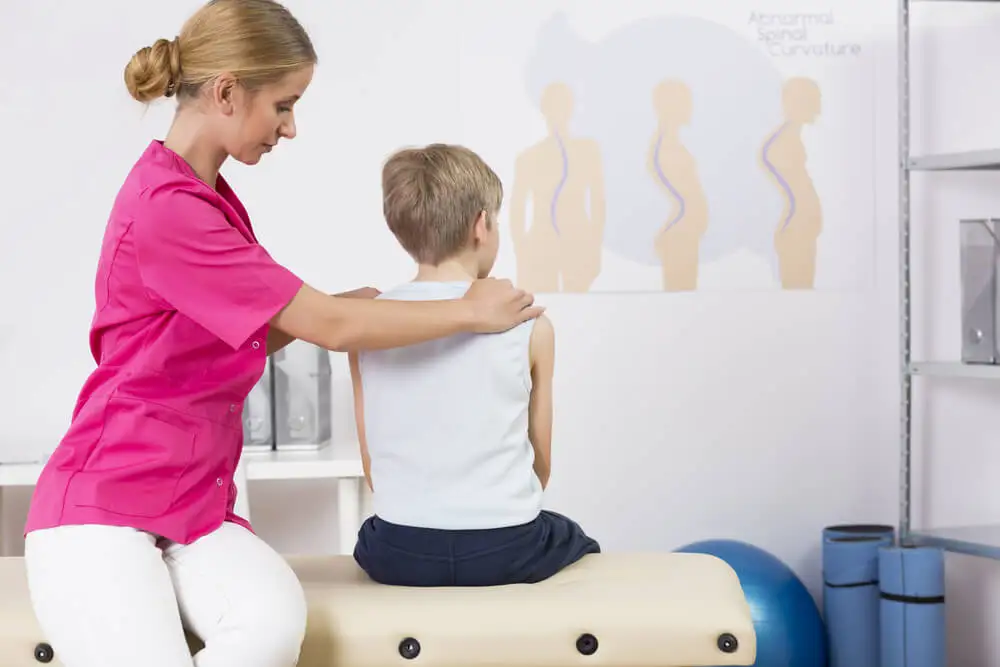What is Kyphosis and Why Does it Occur? 6 Tips to Treat Kyphosis


Reviewed and approved by the nurse Leidy Mora Molina
Kyphosis is a deviation of the spine that consists of abnormal curvature or arching of the spine. Thus, the back shows a hump-like appearance, usually at the level of the shoulder blades.
In addition, it may be accompanied by symptoms such as pain or difficulty breathing. This condition may be congenital in origin or have other causes, among which fractures, wear and tear, and osteoporosis can be mentioned.
For diagnosis, certain tests are performed, such as X-rays and MRI scans. The treatment of kyphosis depends on the age or cause. It includes corrective surgery, bracing, physiotherapy, and certain painkillers. Do you want to find out more about this disease? If so, keep reading.
What is kyphosis? Types and symptoms

There are several types of spinal deviations. Scoliosis is a deviation that occurs laterally (if you look at the person from the front or from the back), while lordosis is the inward curvature of the lower back (waist). Kyphosis is the third variant.
This word derives from the Greek word kyphós, which means “stooped.” In particular, kyphosis consists of an abnormal or exaggerated curvature of the spine in the upper back. It’s usually observed as a forward fall of the neck, shoulders, and head, producing an arching or rounding in the form of a hump.
According to research, the overall prevalence of dorsal kyphosis is 2.8 %; it’s less frequent among women (2.1 %) than among men (3.6 %). However, with age, the figures change, as in the case of postmenopausal women, it can be around 30 %.
Types of kyphosis
Several types of kyphosis are described:
- Postural: It can be caused by not having good postural hygiene, which leads to the deformation of muscles, bones, and joints.
- Congenital: In some cases, this deviation can be observed from the moment of birth.
- Juvenile (also called dorsal kyphosis): As its name implies, it affects the dorsal vertebrae of the back.
- Kyphosis caused by age: In older people, bone and muscle weakening occurs, which may lead to the appearance of this type of deviation.
The symptoms
The most visible sign of kyphosis is the rounded appearance of the back at the level of the shoulder blades, although this can also be observed in the neck.
In addition, other symptoms may appear, such as the following:
- Stiffness in the spine
- Tenderness and pain in the neck and shoulders
- Difficulty breathing
- General tiredness
- Numbness or difficulty in performing some movements
We think you may also enjoy reading this article: Relieve Back Pain with a Simple Breathing Technique
The causes of kyphosis
When kyphosis occurs, the vertebrae lose their shape, acquiring a wedge-like appearance, thicker in one part than in another. Let’s take a look at what the most common causes are.
Scheuermann’s disease
Also called “growth dystrophy,” Scheuermann’s disease affects the disco vertebral complex in adolescents. Its cause is unknown, although there may be associated mechanical factors (especially in athletes), as well as genetic factors. In addition to kyphosis, it causes various spinal problems, including degenerative disc lesions.
Bone weakening
In older adults, the bone weakening and loss of skeletal mass associated with osteoporosis can result in curvatures, fractures, and malformations of the spine, especially if the vertebrae suffer compression fractures.
Injuries and trauma
In addition to the aforementioned fractures, there may be other types of injuries affecting the spine, both from the point of view of the vertebrae, the discs, and even the spine.
Degeneration of the discs
Likewise, with age, as well as possible hernias, the discs that separate the vertebrae and that serve as cushioning between them may dry out or become compressed. This can cause or worsen kyphosis.
Congenital problems
In some cases, the bones of the spine do not develop well during the gestation period. This, in some cases, is associated with diseases such as Ehlers-Danlos syndrome.
Other causes of kyphosis
Kyphosis can also occur in young and older adults due to other causes, such as:
- Tumors and oncological treatments
- Cerebral palsy
- Spondylolisthesis
- Hormonal or endocrine diseases
- Connective tissue problems
- Tuberculosis
- Hyperlaxity
- Neurofibromatosis
- Paget’s disease
- Scoliosis
Like this article? You may also like to read: Arnica and Coconut Oil Ointment to Treat Lower Back Pain
What is the diagnosis like?

To begin with, the physician will perform a general examination, which includes taking measurements, mainly of the person’s height. A reflex and muscle strength evaluation may also be performed.
In addition, imaging tests are performed for various purposes. These often include:
- X-rays: Allow doctors to observe the degree of deviation of the spine and to detect abnormalities in the vertebrae.
- Tomography: This test is usually taken in case a more detailed study is required.
- MRI: This is taken when an infection or tumor is suspected.
- Neurological tests are used to detect weakness, paralysis or lack of sensitivity.
- Bone densimetry: This text is used in the case of patients with a diagnosis or suspicion of osteoporosis.
- Other tests, such as pulmonary function, in cases where this is affected by kyphosis.
Treatment of kyphosis
Treatment of kyphosis will depend on the cause and severity or progression of the disease, as well as the age of the individual. Such treatment may include some or several of the following alternatives, which may be combined with each other.
Medications
Among the recommended medications, over-the-counter analgesics such as acetaminophen, ibuprofen, or naproxen are usually used. If there’s a lot of pain, other stronger ones should be used, but with a doctor’s prescription.
On the other hand, in people with osteoporosis, drugs for bone strengthening (alendronate, ibandronate, risedronate, among others) are recommended, which help prevent fractures.
Physiotherapy
The physiotherapist can make use of different techniques to help in the treatment of kyphosis:
- Massage to the affected muscle groups
- Breathing exercises
- Postural re-education work
- Electrotherapy, thermotherapy, or ultrasound
Surgery
In severe cases where kyphosis causes spinal or nerve compression, if the curvature is pronounced (60 degrees) and causes a lot of pain, or if there’s an infection or a tumor, surgery may be required. Spinal fusion is usually done using metal rods and screws. Recovery can be slow.
Tips for care and prevention
If this condition is congenital in origin, it’s not possible to prevent kyphosis. However, at other times, the risk of its occurrence or aggravation can be reduced, helping to reduce the need for surgery. In this order of ideas, here are some tips to keep in mind for both prevention and care when there’s already a diagnosis.
1. Wearing a back brace
The use of an orthopedic brace that partially immobilizes can help, especially in children and adolescents with Scheuermann’s disease, to stop the progression of the disease.
It should be noted that the brace should be used correctly, always following the doctor’s recommendations regarding time – i.e., don’t remove it, even if it’s uncomfortable.
2. Correct posture
It’s necessary to try to maintain good postural hygiene, especially for the elderly and those who, because of their work, have to sit for a long time in front of the computer. This should also apply when watching television, on the computer, or checking your cellphone.
3. Avoid a sedentary lifestyle
Among the various consequences of a sedentary lifestyle is the loss of mass, strength, and endurance in the muscles precisely because they’re not used. This also affects the back area.
4. Maintain a healthy weight
According to studies, postural deviations tend to occur in people with obesity since the direct vertical compressive load increases, particularly affecting the spine, knees, and ankles. This can cause complications in people with kyphosis. Therefore, physical activity and a healthy diet should be an integral part of the treatment of this disease.
5. Back stretching exercises
For some types of kyphosis, the patient may experience some improvement through stretching and back-strengthening exercises. Some of these can be done by the person alone, but in others, the help of a professional (physiotherapist) is required.
6. Go to the doctor for regular check-ups
It’s important to go for regular check-ups in the following cases:
- When there’s a personal history of deviations (for example, scoliosis)
- If you suffer from osteoporosis or are over 60 years of age
Let us remember that an early diagnosis can mean a more effective or less invasive treatment.
The possible consequences and complications of kyphosis
The measures and treatments mentioned above can help to reduce the risk of suffering complications and various consequences, such as the following:
- Back pain, which can become disabling.
- Difficulty breathing: Because of the incorrect curvature, there may be pressure on the lungs.
- Performance of tasks: This may include difficulty walking, sitting, or looking up; it even sometimes prevents driving.
- Insomnia: According to research, this disease can affect the quality of rest in some people.
- Digestive problems: This is caused by compressing the digestive system, especially the stomach. It may also be associated with problems such as reflux and difficulty swallowing.
- Low self-esteem: People with kyphosis may have a negative self-perception of their body image.
Prognosis of kyphosis
The prognosis of kyphosis depends on the type and severity, as well as the age of the individual. For adolescents with Scheuermann’s disease, the disease usually stops when they stop growing, without the need for surgery. However, they may be required to continue wearing a brace.
For older adults, however, the timing and adherence to treatment recommendations are critical. For them, it’s necessary to take measures because their bones are usually weaker, and complications may occur.
All cited sources were thoroughly reviewed by our team to ensure their quality, reliability, currency, and validity. The bibliography of this article was considered reliable and of academic or scientific accuracy.
- Ávila-Ramírez J, Reyes-Rodríguez V. La obesidad y el sobrepeso, su efecto sobre la columna lumbar. Revista Mexicana de Neurociencia. 2009; 10(3): 220-223.
- Cervantes V, Otero C, Mayoralas S, Díaz Lobato S. Ventilación mecánica no invasiva en enfermedades restrictivas. Revista Americana de Medicina Respiratoria. 2021; 21(1): 35- 40.
- Durán S, Rodilla V. Abordaje de la enfermedad de Paget en Atención Primaria. A propósito de un caso. Medicina General. 2000: 508-510.
- Frank M, Engell V, Andersen M, et al. Prevalence, concordance, and heritability of scheuermann kyphosis based on a study of twins damborg. The Journal of Bone & Joint Surgery. 2006; 88(10): 2133 – 2136.
- Garreau de Loubresse C, Lonjon G, Ferrero G. Cifosis patológicas. EMC – Aparato Locomotor. 2020; 53(3): 1-24.
- Marty-Poumarat C, Carlier R. Enfermedad de Scheuermann. EMC – Aparato Locomotor. 2017; 50(4): 1-13.
- Puerto Martínez M. Caracterización clínica y manejo del Síndrome de Ehlers Danlos. Rev Ciencias Médicas. 2017; 21(4): 124-150.
- Tampe V, Schonhaut L, Espinoza A, Dockendorff I. Hipoplasia vertebral asociada a cifosis toracolumbar en lactantes, ¿variante anatómica? Casos clínicos. Rev Chil Pediatr. 2018; 89(2): 251-256.
- Vital J, Pedram M. Espondilolistesis ístmica lítica. EMC – Aparato Locomotor. 2005; 38(3): 1-20.
- Frank Pessler, MD, PhD, Helmholtz Centre for Infection Research. https://www.msdmanuals.com/es/professional/pediatr%C3%ADa/trastornos-del-tejido-conectivo-en-niños/s%C3%ADndrome-de-ehlers-danlos
This text is provided for informational purposes only and does not replace consultation with a professional. If in doubt, consult your specialist.








